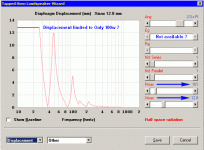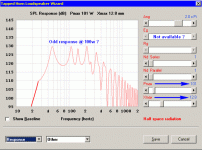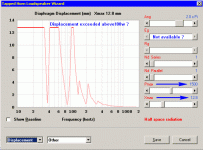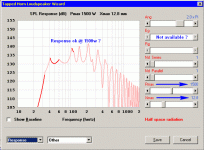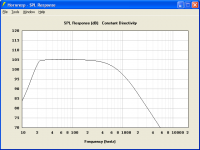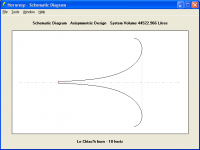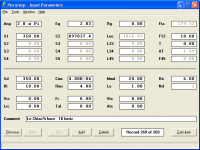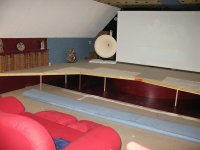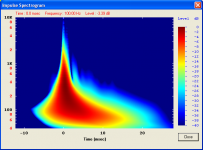If the file to be imported is placed in the Import directory while Hornresp is running, it may not be visible. Simplest solution is to just restart Hornresp.
Check that - I'm seeing mixed behavior on this - my Windows 7 machine does not mind at all, yet I seem to recall experiencing this with Windows XP. Perhaps a recent update remedied this?
Hi littlemike,
The file to be imported can be placed in the Import directory while Hornresp is running. If the Import Hornresp Record tool has already been opened, the file will not be shown in the list. In that case, simply close the tool and re-open to display the file name.
Imported file records are added to the end of the main Hornresp data file.
There has been no recent update to change the import functionality.
Kind regards,
David
Although Hornresp will generate .aks export files for use with Akabak it will not import them.
Exactly
Kind regards,
David
David,
I have a little hornresp design at http://www.diyaudio.com/forums/subwoofers/195974-mcm-8-55-2421-isobaric-6.html post #60
Any insight would be much appreciated as I have just started playing with Hornresp.
Thanks,
rev.
I have a little hornresp design at http://www.diyaudio.com/forums/subwoofers/195974-mcm-8-55-2421-isobaric-6.html post #60
Any insight would be much appreciated as I have just started playing with Hornresp.
Thanks,
rev.
Strange Results ?
@ David McBean
Hi, Re this thread http://www.diyaudio.com/forums/subwoofers/200196-my-first-th-design.html & tb46's TH design he kindly did for me fane_001.txt
I'm hoping you can shed some light on my trying to establish why i "appear" to see conflicting etc data !
For the 1500W tests i set the Input Parameter - Eg = 109 Volts
For the 100W tests i set the Input Parameter - Eg = 28.28 Volts
For some reason Eg isn't available on the slider ?
My main concern though is, why the design "seems" to be Extemely displacement limited. Considering this a 1500W driver with Xmax of 12.75mm !
TIA
@ David McBean
Hi, Re this thread http://www.diyaudio.com/forums/subwoofers/200196-my-first-th-design.html & tb46's TH design he kindly did for me fane_001.txt
I'm hoping you can shed some light on my trying to establish why i "appear" to see conflicting etc data !
For the 1500W tests i set the Input Parameter - Eg = 109 Volts
For the 100W tests i set the Input Parameter - Eg = 28.28 Volts
For some reason Eg isn't available on the slider ?
My main concern though is, why the design "seems" to be Extemely displacement limited. Considering this a 1500W driver with Xmax of 12.75mm !
TIA
Attachments
David,
I have a little hornresp design at http://www.diyaudio.com/forums/subwoofers/195974-mcm-8-55-2421-isobaric-6.html post #60
Any insight would be much appreciated as I have just started playing with Hornresp.
Thanks,
rev.
Hi rev,
You are on the right track as far as specifying a tapped horn design in Hornresp is concerned. Because the results shown appear to have been generated by input parameters different to those given, it is difficult for me to comment further.
My practical speaker-building experience is relatively limited, so I am probably not the best person to be commenting on your design anyway
Kind regards,
David
Hi Zero D,
Setting Eg to 28.28 volts means that the power delivered to a pure 8 ohm resistive load will be 100 watts. Because the impedance of a nominal 8 ohm loudspeaker varies considerably across its operating frequency range, the actual input power will vary from the nominal 100 watt value, as the frequency changes.
When the Pmax slider is set to 100 watts the input power is maintained at a constant value across the frequency range, independent of changes in speaker impedance. This means that the value of Eg actually changes to keep the power constant. In this case only the input power is of interest, so the Eg slider is automatically disabled when the Pmax slider is activated.
To summarise the above, in the first case a constant voltage source of 28.28 volts is used, whereas in the second case a constant power source of 100 watts is used. This is why the results are different.
Hornresp assumes linear behaviour at all input voltage levels. No allowance is made for low frequency high power amplitude compression, which may be the actual case in practice.
Kind regards,
David
I'm hoping you can shed some light on my trying to establish why i "appear" to see conflicting etc data !
For the 100W tests i set the Input Parameter - Eg = 28.28 Volts
Setting Eg to 28.28 volts means that the power delivered to a pure 8 ohm resistive load will be 100 watts. Because the impedance of a nominal 8 ohm loudspeaker varies considerably across its operating frequency range, the actual input power will vary from the nominal 100 watt value, as the frequency changes.
For some reason Eg isn't available on the slider ?
When the Pmax slider is set to 100 watts the input power is maintained at a constant value across the frequency range, independent of changes in speaker impedance. This means that the value of Eg actually changes to keep the power constant. In this case only the input power is of interest, so the Eg slider is automatically disabled when the Pmax slider is activated.
To summarise the above, in the first case a constant voltage source of 28.28 volts is used, whereas in the second case a constant power source of 100 watts is used. This is why the results are different.
My main concern though is, why the design "seems" to be Extemely displacement limited. Considering this a 1500W driver with Xmax of 12.75mm !
Hornresp assumes linear behaviour at all input voltage levels. No allowance is made for low frequency high power amplitude compression, which may be the actual case in practice.
Kind regards,
David
Last edited:
Considering this a 1500W driver with Xmax of 12.75mm !
But that doesn't mean that you can get both at the same time everywhere. At some frequencies you will hit Xmax at low power, at other frequencies you will not get anywhere near Xmax with 1500W input.
Regards,
Bjørn
Regarding maximum output.
Take a simple look at the drivers resonant peak impedance. Usually 10 to 12 times it's rated impedance. Your amp will be putting 10 to 12 times less power into your driver in this area of it's use. Amplifiers are designed to behave as a voltage source. But they run into problems when the current across the impedance is greater than they can provide.
Always be careful what you trust in terms of speaker marketing! Much smoke and oh so many mirrors.
Take a simple look at the drivers resonant peak impedance. Usually 10 to 12 times it's rated impedance. Your amp will be putting 10 to 12 times less power into your driver in this area of it's use. Amplifiers are designed to behave as a voltage source. But they run into problems when the current across the impedance is greater than they can provide.
Always be careful what you trust in terms of speaker marketing! Much smoke and oh so many mirrors.
@ David McBean
Thanks for the concise explanations, it's a lot clearer now & i now understand why i was seeing "seemingly" conflicting data. So all is well there
& i now understand why i was seeing "seemingly" conflicting data. So all is well there 
@ Kolbrek
Thanks i realise that though. My concern was wondering why i was seeing such poor results.
i realise that though. My concern was wondering why i was seeing such poor results.
@ mwmkravchenko
Indeed, good points
Thanks for the concise explanations, it's a lot clearer now
@ Kolbrek
Thanks
@ mwmkravchenko
Indeed, good points
Hornresp Update
Hi Everyone,
The maximum permissible S2 value for a Le Cléac'h horn has been increased to 999999.9 sq cm. This means that a fully-formed 180 degree horn with a cutoff frequency down to 18 hertz can now be simulated (see attached screenprints). Even lower cutoff frequencies can be accommodated if the mouth angle is allowed to be less than 180 degrees - which is probably going to be the case regardless, given that a fully-formed 18Hz horn has a maximum diameter of 10.69 metres .
.
While it is still only possible to simulate horns with a maximum mouth angle of 180 degrees, extending the foldback of a practical horn beyond that limit is unlikely to make any audible difference to the radiated sound anyway. Construction data for a 360 degree axisymmetric Le Cléac'h horn can however be obtained if necessary by exporting the "exact profile" from the schematic diagram window.
My thanks to witasso for prompting the initial discussion on this matter, and to Jean-Michel and Mark for helping me to clarify my thinking, particularly in relation to Le Cléac'h horns.
The latest Hornresp release is Version 28.80.
Could you please let me know if you find any bugs.
Kind regards,
David
Hi Everyone,
The maximum permissible S2 value for a Le Cléac'h horn has been increased to 999999.9 sq cm. This means that a fully-formed 180 degree horn with a cutoff frequency down to 18 hertz can now be simulated (see attached screenprints). Even lower cutoff frequencies can be accommodated if the mouth angle is allowed to be less than 180 degrees - which is probably going to be the case regardless, given that a fully-formed 18Hz horn has a maximum diameter of 10.69 metres
While it is still only possible to simulate horns with a maximum mouth angle of 180 degrees, extending the foldback of a practical horn beyond that limit is unlikely to make any audible difference to the radiated sound anyway. Construction data for a 360 degree axisymmetric Le Cléac'h horn can however be obtained if necessary by exporting the "exact profile" from the schematic diagram window.
My thanks to witasso for prompting the initial discussion on this matter, and to Jean-Michel and Mark for helping me to clarify my thinking, particularly in relation to Le Cléac'h horns.
The latest Hornresp release is Version 28.80.
Could you please let me know if you find any bugs.
Kind regards,
David
Attachments
Hi David, I'm not sure if anyone else has mentioned any problems with this but the window for Particle Velocity appears around 2/3 size of the main Hornresp window and unresizable.
The graph and controls are partially obscured and I can't alter the window to properly see the results.
I'm running on XP SP3 at 1920x1080 if that's any help!
Hi Chucky,
Hopefully the problem you have been experiencing has been fixed in the latest Hornresp release. Could you please confirm that everything now displays correctly. Product Number 2880-111114 refers.
Kind regards,
David
Hello, David,
Thank you a lot for that.
Here attached a picture of a Le Cléac'h bass horn ("stand" type) that my friend Didier is currently finishing to build.
(BTW, the white horn is a 200Hz Le Cléac'h horn)
Best regards from Paris, France
Jean-Michel Le Cléac'h
Thank you a lot for that.
Here attached a picture of a Le Cléac'h bass horn ("stand" type) that my friend Didier is currently finishing to build.
(BTW, the white horn is a 200Hz Le Cléac'h horn)
Best regards from Paris, France
Jean-Michel Le Cléac'h
Hi Everyone,
The maximum permissible S2 value for a Le Cléac'h horn has been increased to 999999.9 sq cm. This means that a fully-formed 180 degree horn with a cutoff frequency down to 18 hertz can now be simulated (see attached screenprints). Even lower cutoff frequencies can be accommodated if the mouth angle is allowed to be less than 180 degrees - which is probably going to be the case regardless, given that a fully-formed 18Hz horn has a maximum diameter of 10.69 metres.
While it is still only possible to simulate horns with a maximum mouth angle of 180 degrees, extending the foldback of a practical horn beyond that limit is unlikely to make any audible difference to the radiated sound anyway. Construction data for a 360 degree axisymmetric Le Cléac'h horn can however be obtained if necessary by exporting the "exact profile" from the schematic diagram window.
My thanks to witasso for prompting the initial discussion on this matter, and to Jean-Michel and Mark for helping me to clarify my thinking, particularly in relation to Le Cléac'h horns.
The latest Hornresp release is Version 28.80.
Could you please let me know if you find any bugs.
Kind regards,
David
Attachments
Last edited:
Here attached a picture of a Le Cléac'h bass horn ("stand" type) that my friend Didier is currently finishing to build.
(BTW, the white horn is a 200Hz Le Cléac'h horn)
Hi Jean-Michel,
Thanks for posting the picture - an impressive system indeed.
Your "stand" type configuration is a very elegant way of minimising the overall visual impact of the bass horn.
Kind regards,
David
Hi David,
Please disregard the email I sent you, I hadn't seen your reply to this post yet!
The problem has been fixed and everything now displays correctly. Many thanks!!
Chucky
Hi Chucky,
So far so good - what happens though, when you calculate the results for default record number 1, and then select Tools > Impulse > Spectrogram from the SPL Response window? Do you get a fatal error, by any chance? The correct result should look like the attachment below.
Kind regards,
David
Attachments
I am running in a set of drivers ready for T/S measurements.
What should I measure to get the best or easiest entry for Hornresp?
Attachments
Thanks Neo.
Just to confirm I am reading the input page correctly.
I need
Sd, Vas, Fs, Re, Qes, Qms Le. 7parameters.
When I measure T/S I use added weight to derive Vas. Is that accurate enough?
I do not measure Le.
Any suggestions that give a good enough result for input to Hornresp?
Just to confirm I am reading the input page correctly.
I need
Sd, Vas, Fs, Re, Qes, Qms Le. 7parameters.
When I measure T/S I use added weight to derive Vas. Is that accurate enough?
I do not measure Le.
Any suggestions that give a good enough result for input to Hornresp?
- Home
- Loudspeakers
- Subwoofers
- Hornresp
